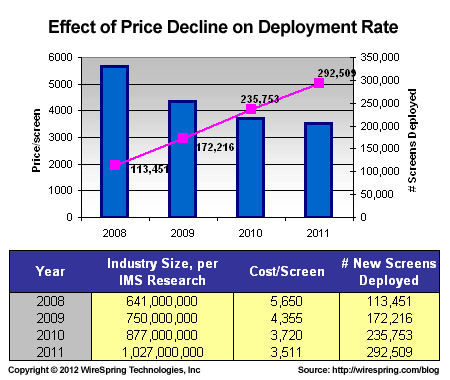Are aggregators long for this world? What about DOOH advertising networks in general?
Ask anyone in the business of selling ads on digital signs and they'll tell you that more often than not, it's an uphill battle. Audiences are too small, the few established metrics are incompatible with traditional planning tools and media buys are either too big for small advertisers or too small for big ones. What's more, unlike TV or Internet, DOOH advertising isn't a "must have" for anyone. And unlike mobile, it doesn't guarantee the same kind of direct, 1:1 connection that marketers love (even though they usually don't properly utilize it).
Now imagine that you have all of those problems and you then ask somebody else to do the selling for you -- because that's precisely how a lot of network-aggregator relationships look to outsiders. Unfortunately, without the accountability that comes with owning and operating the screens, aggregators have a hard time speaking to potential buyers with authority. Consequently, their guarantees can look iffy and can be literally unverifiable at times. That might cut the mustard for print and TV ads (where decades of unverifiability have somehow quelled advertiser fears), but for new media it makes for a very difficult pitch.
Short answer: Yes with a "but". Long answer: No with an "if".
You can see how the aggregators might have a hard time doing their jobs. However, remove their special challenges from the paragraphs above and things still don't look so rosy for those who own and operate purely advertising-driven networks, either. The simple fact is that the problems we were dealing with 5 -- even 10 -- years ago remain virtually untouched today. Couple that with the impossible fickleness of ad agencies and the plethora of low-cost, high-value marketing options available to small advertisers, and few (aside from the network owners, of course) have the incentive or motivation to try and solve the issues at hand.
In the past, we've offered up a few tips that customers have passed along to us about selling advertising on digital signs. But nothing is going to help a network that doesn't have a solid value proposition -- and an even more solid sales team -- in place. And even then, it's easy to get blindsided by the paradox where better spots can be harder to sell. That said, there is some good news. For example, as the cost of owning and operating a network continues to decrease, fewer ads have to be sold to break even. Also, well-funded networks can capitalize on the misfortunes of struggling networks to solve the problem of front-loaded scale. Still, aside from those networks and screens that are tied more closely to some sort of merchandising function, I predict things will get worse for pure-play DOOH network owners before they get better.
What does this mean for the digital signage industry in general?

Since at least 2007, digital signage deployments for non-advertising uses have outpaced advertising deployments by a rate of about 1.5 to 1. (I believe that number originally came from PQ Media, although I don't have the link handy.) So if we do some quick and dirty math based on our own digital signage pricing guide (which we recently extrapolated against industry size data from IMS), we see that over 800,000 screens have been deployed in the US over the last four years -- at an increasing pace, no less. Of those, we can then assume that almost 490,000 were installed for some purpose not primarily tied to advertising, whether it be corporate communications, wayfinding, merchandising, or something else entirely.
In short, even if DOOH advertising networks do face a period of decline that's foreshadowed by the difficulties of their aggregator cousins, there is sufficient growth elsewhere to bolster the overall market against it. And if you're a vendor, it's a great reason to look into diversifying your customer base.

 Subscribe to the Digital Signage Insider RSS feed
Subscribe to the Digital Signage Insider RSS feed
Comments
RSS feed for comments to this post